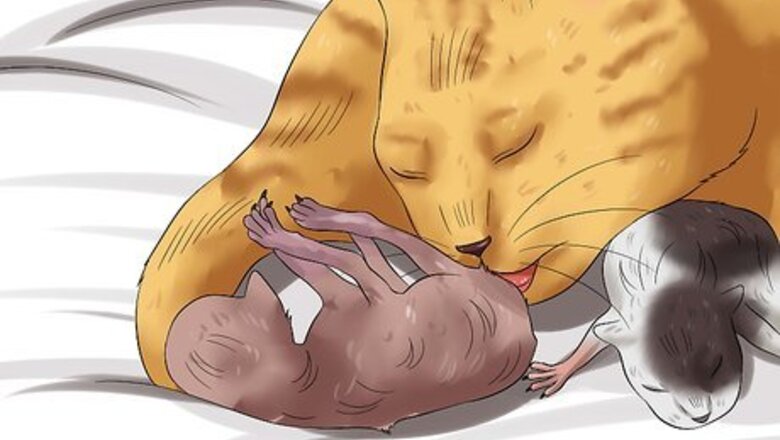
views
Nurturing Newborn Kittens
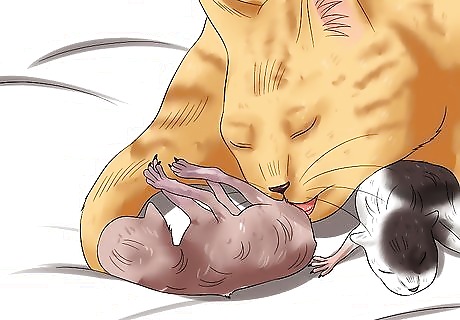
Watch for problems during labor. Watch the mother (queen) cat during labor, but give her space. Her instinct will kick in and she won't need you to be part of labor and delivery. Instead, you'll need to watch and ensure that nothing goes wrong medically. Here are things to look for: The kitten is not freed from the birth sac: The kittens usually emerge in individual birth sacs that the mother then licks away. If she doesn't clean it away or rejects the kitten, you may need to take a soft towel and gently rub off the sac. If in doubt, give the mother a little time to tend to the kitten before doing this or she may reject the kitten. The mother is pushing hard for more than 20 minutes: This is a sign she is having difficulty birthing. Have a quick peek to see if a kitten is half out. If so, hold the kitten with a soft, clean towel and gently pull backwards and downwards. If the kitten doesn't come out easily then call the vet. Likewise, if you see nothing, call the vet. The kitten doesn't suckle after one hour: Most kittens suckle within an hour or two of being born. If this doesn't happen, gently place the kitten by the mother's teats which helps the kitten get the scent of milk. If after half an hour the kitten still isn't suckling, gently open the kitten's mouth and latch him onto a nipple to suckle. If after that the kitten doesn't feed, then you might need to hand raise the kitten.
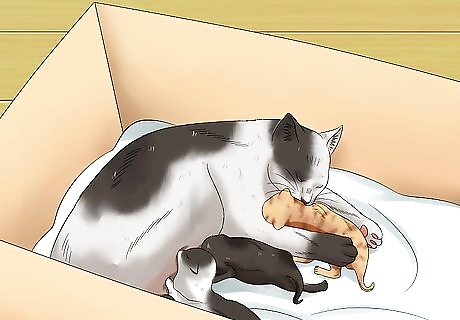
Make the mother cat comfortable after labor. Since the mother cat will be primarily caring for the kittens during the first four weeks of their lives, ensure she has everything she needs. The mother will most likely choose a nesting spot where you can make her comfortable. Put a box with some clean, dry bedding in the room and keep the temperature roughly the same temperature you would feel comfortable in wearing jeans and a T-shirt. You should also make sure the mother and kittens have private time away from a steady stream of visitors, which could make her feel threatened. Room temperature is important. Too hot and the mother will become distressed, but too cold and the kittens risk hypothermia. Newborn kittens cannot regulate their body temperatures and depend on the mother to stay warm.
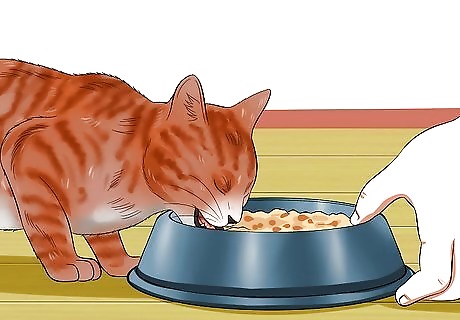
Give the mother cat nutritious food. The mother will double her food intake after labor, so give plenty of high quality food and continue supplementing her with vitamins and minerals. Kitten food is ideal as it has a higher calorie content than regular food and has added vitamins and minerals. Avoid giving her milk to drink, since it could give her diarrhea. Place food and water close to her nesting place so she won't have to leave her kittens. You should also put a litter box within sight of the nest so can relieve herself and stay close to the kittens. Kittens are born deaf and blind. Their most developed sense is smell which they use to find their mother's milk.
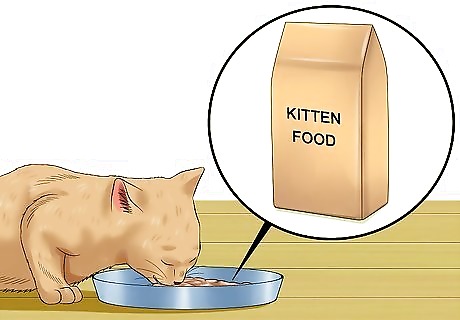
Set out kitten food. While there are many ways to wean a kitten (changing them from mother's milk to solid food), the easiest way is to let the kittens follow the mother's lead. They'll generally do this from the age of four weeks on. You can help by setting out kitten food for the mother. The kittens may only appear curious at first, but as they burn more energy, they'll begin eating the food. The kittens may find it easier to start eating soft food, such as canned kitten food. The mother will encourage weaning by cutting back on nursing sessions. This will motivate the kittens to begin eating solid foods.
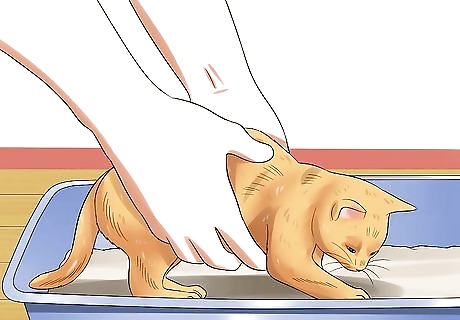
Put out a litter box. As they get older, the kittens will begin to move, explore, play, and stray from the nest. Now is a good time to set out a large, low-sided litter tray. Show the kittens where it is to prevent future toileting accidents. It may help to have the mother poop in the tray (or set some of her poop in the tray). This will signal to the kittens that the tray is the toileting place. Never use clumping cat litter. If the kitten investigates the litter and swallows some, the litter can clump within the gut causing a blockage.
Keeping the Kittens Healthy and Social
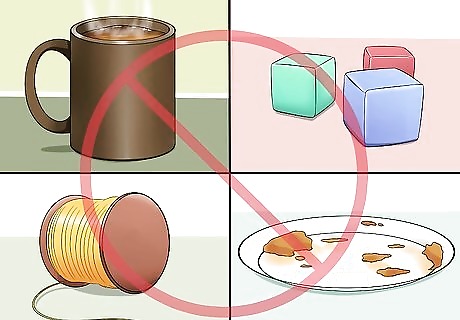
Create a secure environment. Keep the kittens safe by removing hazards like deep water bottles, strings, ribbons, or small toys. Doing so can keep your cat from drowning or choking. You should also take care where you put hot drinks in case curious kittens knock into them and get scalded. Plates with human food should also be removed from the kittens since they could eat food that irritates their stomachs. Supervise any other pets (especially dogs) around the kittens and seal off places where kittens could crawl inside and become stuck. Also be careful when entering a room where the kittens are living. Kittens love to dash around in an unpredictable way and it is easy to tread on a kitten or fall over one.

Consider when to home out the kittens. If you've decided not to keep the kittens, you can begin finding new homes for them as soon as they're eight weeks old. While some suggest you should wait until 12 weeks, kittens don't socialize as much by this point, making it harder for them to adapt to their new homes. This is why it's best to start looking for homes between eight and 12 weeks old. This timeframe lets the kittens spend plenty of time with their mother and allows them to accept their new homes.
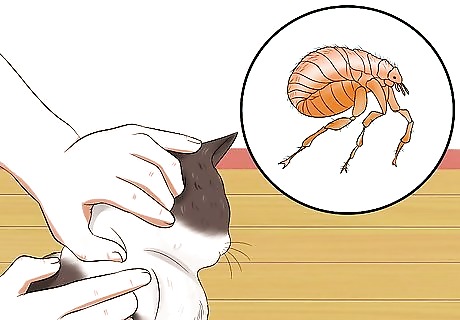
Check the kittens and mother for fleas. Look closely at their skin and fur for small black spots. You can also brush the fur and shake the brush onto a white, wet paper towel. You might see red spots (dried blood) and flea dirt (flea droppings). If the kittens or mother have fleas, ask your veterinarian to recommend a flea product designed for use in kittens. Take care to treat the mother, wait for medication to dry, and return her to the kittens. If your vet finds the kittens have roundworms passed on from mother's milk, the kittens might need to be treated with a liquid medication (fenbendazole) that is given by syringe. You can give this to kittens that are at least three weeks old. Repeat treatment every two to three weeks.
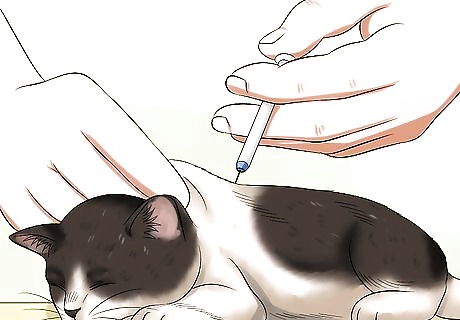
Vaccinate the kittens. You can get the kittens vaccinated once they are at least nine weeks old. Consult with the veterinarian to determine which vaccinations the kittens need. Your vet will probably recommend to vaccinate against feline distemper, which your cat will likely be exposed to. On the other hand, the vet may not recommend vaccinating against feline leukaemia if your kittens will remain indoors. This is because feline leukaemia is spread by close contact with other cats. Even if the kitten is going to be an indoor cat, vaccination is still advisable, although your veterinarian can advise you as to which components are essential and which are optional.
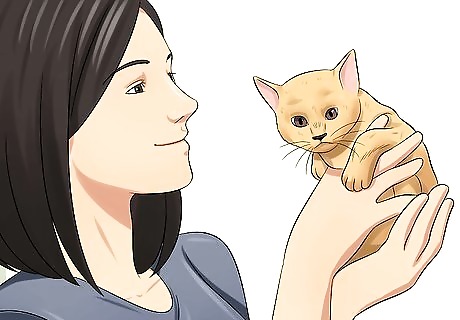
Socialize the kittens. When the kittens are three or four weeks old or no longer constantly nursing, invite friends over to handle and play with the kittens. Make sure this is a controlled introduction, so the kittens aren't overwhelmed or frightened (which could be traumatizing). Keep in mind that it's important to expose your kittens to a variety of people, sounds, smells, and environments before they turn 12 weeks old. Around this time, it becomes harder for them to accept new situations and experiences. If you socialize the kittens at an early age, they'll be accepting, confident, well-adjusted, and outgoing, characteristics they'll keep as they grow into adult cats.




















Comments
0 comment